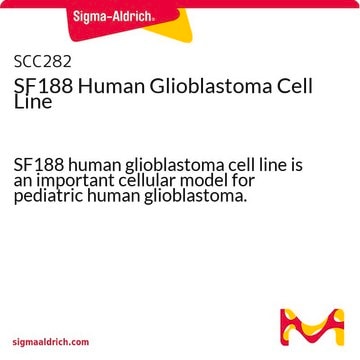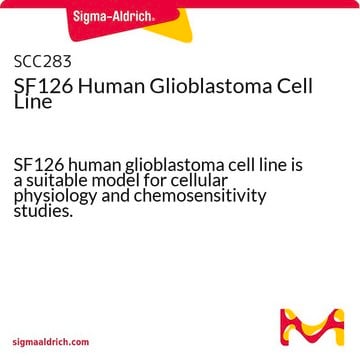08061901
U-373 MG (Uppsala) cell line
Synonym(s):
U-373MG Cells, U373-MG Cells, U373MG Cells
Sign Into View Organizational & Contract Pricing
All Photos(1)
About This Item
UNSPSC Code:
41106514
Recommended Products
biological source
human brain
form
liquid
growth mode
Adherent
karyotype
2n = 46
morphology
Pleomorphic/astrocytoid
receptors
PDGFR alpha and EGFR. See Nistér M. et al., (1988) & (1991)
technique(s)
cell culture | mammalian: suitable
relevant disease(s)
cancer
shipped in
dry ice
storage temp.
−196°C
Cell Line Origin
Human glioblastoma astrocytoma
Cell Line Description
A human glioblastoma astrocytoma derived from a malignant tumour by explant technique. This catalogue entry represents a new deposit of U-373 MG obtained from the originator′s laboratory in Uppsala; it has been designated U-373 MG (Uppsala) to distinguish it from U-373 MG (Sigma Catalogue number 89081403) which is now known to be identical, by Short Tandem Repeat (STR)-PCR profiling, to another glioblastoma cell line, U-251 MG (please read below for more information about this discovery). U-373 MG (Uppsala) has been mycoplasma eradicated at ECACC and the stocks available for supply have undergone a further 10 passages without detection of mycoplasma.
Background to the identity query for the cell line U-373 MG: The American Type Culture Collection (ATCC) reported that their stock of U-373 MG had been shown to have differing genetic properties to stock from the originator′s laboratory, and to share similarities with another glioblastoma cell line, U-251. In light of this, ECACC undertook an investigation into the authenticity of its own stock of the U-373 MG cell line. ECACC found similar results to the ATCC i.e. the stock held as U-373 MG was found to be identical by STR-PCR profiling to U-251. The U-373 MG cell line listed under catalogue number 89081403 has been re-named as ′U-251 (formerly known as U-373 MG)′.
Background to the identity query for the cell line U-373 MG: The American Type Culture Collection (ATCC) reported that their stock of U-373 MG had been shown to have differing genetic properties to stock from the originator′s laboratory, and to share similarities with another glioblastoma cell line, U-251. In light of this, ECACC undertook an investigation into the authenticity of its own stock of the U-373 MG cell line. ECACC found similar results to the ATCC i.e. the stock held as U-373 MG was found to be identical by STR-PCR profiling to U-251. The U-373 MG cell line listed under catalogue number 89081403 has been re-named as ′U-251 (formerly known as U-373 MG)′.
Application
Culture Medium: EMEM (EBSS) + 2mM Glutamine + 1% Non Essential Amino Acids (NEAA) + 1mM Sodium Pyruvate + 10% Fetal Bovine Serum (FBS).
Biochem/physiol Actions
U-373 MG (Uppsala) is a human glioblastoma astrocytoma derived from a malignant tumour by explant technique.
DNA Profile
STR-PCR Data: Amelogenin: X
CSF1PO: 11,12
D13S317: 8
D16S539: 12,13
D5S818: 12
D7S820: 8.2,12
THO1: 7,9.3
TPOX: 8
vWA: 17,18
CSF1PO: 11,12
D13S317: 8
D16S539: 12,13
D5S818: 12
D7S820: 8.2,12
THO1: 7,9.3
TPOX: 8
vWA: 17,18
Culture Medium
EMEM (EBSS) + 2mM Glutamine + 1% Non Essential Amino Acids (NEAA) + 1mM Sodium Pyruvate (NaP) + 10% Foetal Bovine Serum (FBS).
Subculture Routine
Split sub-confluent cultures (70-80%) 1:3 to 1:6 i.e. seeding at 2-4x10,000 cells/cm2 using 0.25% trypsin or trypsin/EDTA; 5% CO2; 37°C.
Other Notes
Additional freight & handling charges may be applicable for Asia-Pacific shipments. Please check with your local Customer Service representative for more information.
Cultures from HPA Culture Collections and supplied by Sigma are for research purposes only. Enquiries regarding the commercial use of a cell line are referred to the depositor of the cell line. Some cell lines have additional special release conditions such as the requirement for a material transfer agreement to be completed by the potential recipient prior to the supply of the cell line. Please view the Terms & Conditions of Supply for more information.
Cultures from HPA Culture Collections and supplied by Sigma are for research purposes only. Enquiries regarding the commercial use of a cell line are referred to the depositor of the cell line. Some cell lines have additional special release conditions such as the requirement for a material transfer agreement to be completed by the potential recipient prior to the supply of the cell line. Please view the Terms & Conditions of Supply for more information.
Disclaimer
RESEARCH USE ONLY. This product is regulated in France when intended to be used for scientific purposes, including for import and export activities (Article L 1211-1 paragraph 2 of the Public Health Code). The purchaser (i.e. enduser) is required to obtain an import authorization from the France Ministry of Research referred in the Article L1245-5-1 II. of Public Health Code. By ordering this product, you are confirming that you have obtained the proper import authorization.
Storage Class Code
10 - Combustible liquids
WGK
WGK 3
Flash Point(F)
Not applicable
Flash Point(C)
Not applicable
Certificates of Analysis (COA)
Search for Certificates of Analysis (COA) by entering the products Lot/Batch Number. Lot and Batch Numbers can be found on a product’s label following the words ‘Lot’ or ‘Batch’.
Already Own This Product?
Find documentation for the products that you have recently purchased in the Document Library.
Karthik Govindaraju et al.
Bioorganic & medicinal chemistry letters, 28(4), 589-593 (2018-02-08)
In a search of small molecules active against apoptosis-resistant cancer cells, a skeletal rearrangement of alkaloid haemanthamine was utilized to generate a series of compounds possessing the alkaloid montanine ring system. The synthesized compounds were found to inhibit proliferation of
Ramesh Dasari et al.
European journal of medicinal chemistry, 103, 226-237 (2015-09-12)
Many types of cancer, including glioma, melanoma, non-small cell lung cancer (NSCLC), among others, are resistant to proapoptotic stimuli and thus poorly responsive to current therapies based on the induction of apoptosis in cancer cells. The current investigation describes the
Manar Mansour et al.
AMB Express, 10(1), 59-59 (2020-03-30)
Salmonella typhimurium VNP-20009 (VNP) is a non-pathogenic attenuated strain, which, as a facultative anaerobe, preferentially accumulates in hypoxic regions of solid tumors. Here, VNP was utilized as a delivery vehicle of the anti-tumor protein Lipidated azurin, Laz, which is produced
Endrit Elbasani et al.
Viruses, 6(1), 354-370 (2014-01-24)
Human cytomegalovirus (HCMV) has a large 240 kb genome that may encode more than 700 gene products with many of them remaining uncharacterized. Mutagenesis of bacterial artificial chromosome (BAC)-cloned CMV genomes has greatly facilitated the analysis of viral gene functions.
Margaux Colin et al.
Cancers, 11(3) (2019-03-27)
Macropinocytosis is a clathrin-independent endocytosis of extracellular fluid that may contribute to cancer aggressiveness through nutrient supply, recycling of plasma membrane and receptors, and exosome internalization. Macropinocytosis may be notably triggered by epidermal growth factor receptor (EGFR) and platelet-derived growth
Our team of scientists has experience in all areas of research including Life Science, Material Science, Chemical Synthesis, Chromatography, Analytical and many others.
Contact Technical Service




